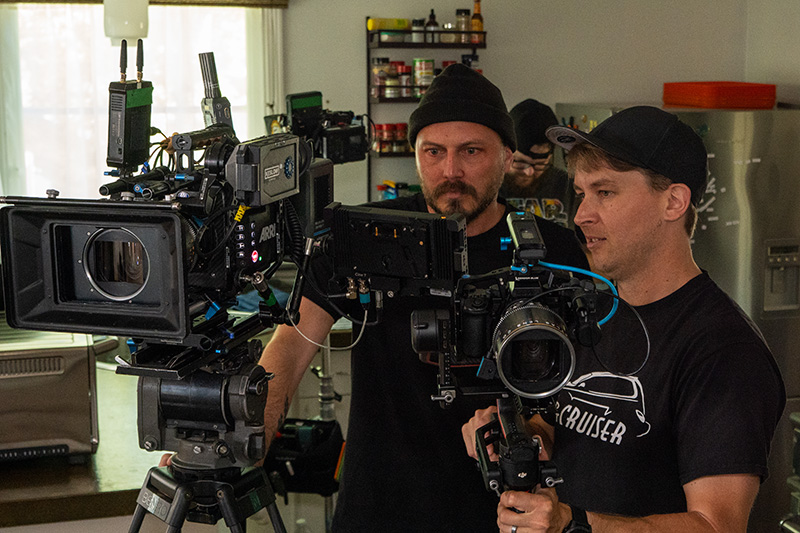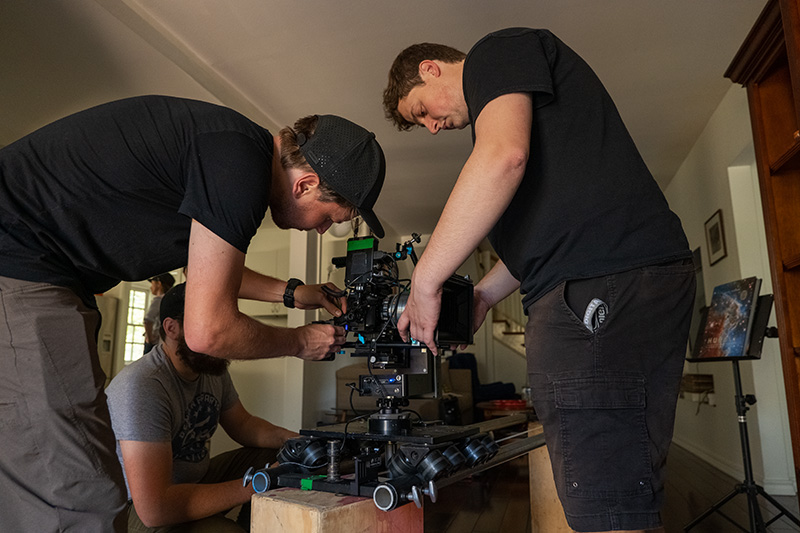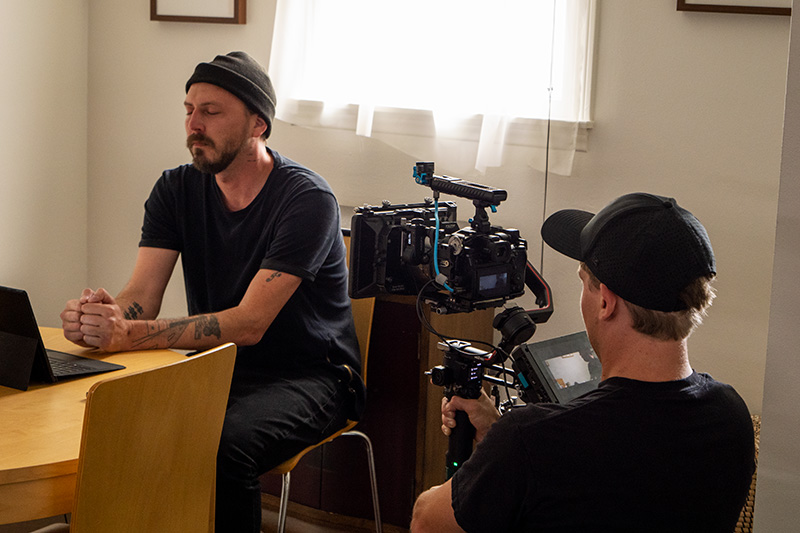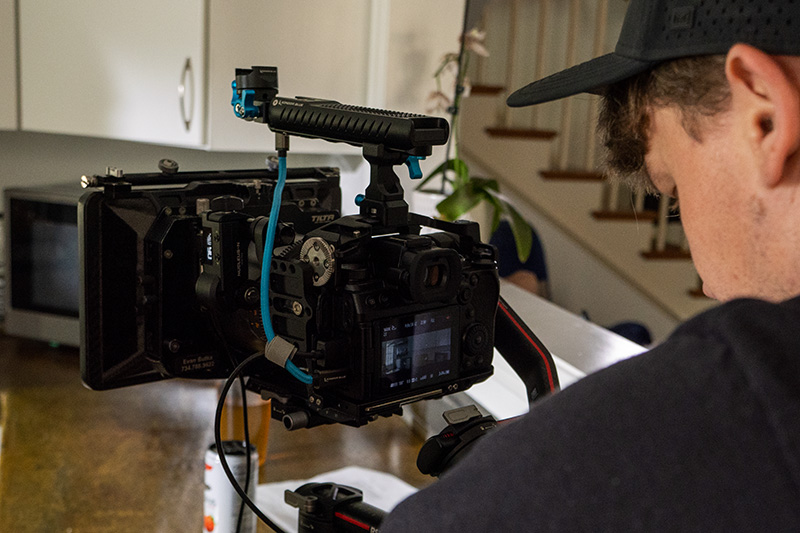Ben Meredith uses Real Time LUT with S5IIX for Orchid

S5IIX: Matching Cameras with Real Time LUT
Filmmaker Ben Meredith and DP Evan Butka use Real Time LUT to match the S5IIX and ARRI ALEXA Mini LF for short film "Orchid"
Directing a film with visual effects can be a challenging experience – especially with a tight schedule – but cinematographer Ben Meredith wanted to make it even harder. Not only is short film Orchid his directorial debut, it’s also his acting debut, starring in the film with actress LeStonja Diaz. “Getting into that headspace and having my friends help coach me through, it has been quite a challenge,” said Meredith, on the set of Orchid.
Orchid is a very personal project for Meredith. Conceived during the pandemic after a break up, Meredith wrote a personal story about miscommunication, or feeling invisible in a relationship. “They feel unseen,” revealed Meredith. “It's nothing negative or toxic, it's just two people slowly drifting away. And that's when the idea of Orchid came up. What if someone was actually physically disappearing limb by limb in front of their fiancée, and they don't even notice.”
Working with cinematographer Evan Butka, Orchid was shot with two different camera systems. Their A-camera was an ARRI ALEXA Mini LF, and for their B-camera, they employed the new LUMIX S5IIX, using its Real Time LUT function to help match ALEXA’s Log C wide gamut color space. “We chose the new Atlas Mercury lenses that have a less aggressive squeeze of 1.5x,” explained Meredith. “Marrying those lenses with these full-frame cameras gave us a very unique look and the ability to match the images a lot better than with almost any other camera.”
(Left to right: Filmmaker Ben Meredith and DP Evan Butka) Short film Orchid was shot with both the ARRI ALEXA Mini LF and the LUMIS S5IIX. (Photo by Brandon Goebel)
Shooting with the S5IIX
Matching large professional cinema cameras with a hybrid mirrorless camera system is difficult but according to Meredith, the full-frame S5IIX has a set of unique features that helped complement the Mini LF. “It [S5IIX] has the ability to shoot ProRes out to an SSD that allowed us to have the same files to match the ALEXA Mini LF’s post workflow,” said Meredith. “It also does a full 6K, which is really nice for us to have the ability to punch in, or move the frame around.”
Because they were shooting at a real house location, Meredith and Butka were able to utilize the S5IIX for shots in which they couldn’t fit the Mini LF, including a motion control dolly track. “We're doing a lot of complicated moves that would have been a lot harder to do with the ALEXA’s form factor – whether on a gigantic Ronin or a Steadicam,” revealed Butka. “But then we'll throw the Panasonic camera with a PL-mount onto a Ronin RS3 and now we can freely move around the space.”
According to Meredith, the biggest advantage of shooting with the S5IIX was set up speed. “We can be on a gimbal and then two minutes later, we're handheld,” he explained. “Two minutes after that we're on a dolly track, and two minutes after that we're on sticks. And it still packs such a large punch for how small it is. Even in a pinch with its internal stabilization and its new autofocus system, we can run super-fast with it and just pick shots off if we're running behind.”
(Left to right: Evan Butka, Brian Lovelace, Sal Natale). According to director Ben Meredith, the biggest advantage of using the S5IIX was the speed at rigging it up for different applications, including a motion control dolly system. (Photo by Brandon Goebel)
Real Time LUT
A LUT (Look-Up Table) is a mathematical formula used to transform colors from one color space to another. For cameras, LUTs are often used to convert the flat, low-contrast footage captured by the camera's sensor into a more visually appealing image. S5II and S5IIX’s Real Time LUT function allows cinematographers to apply a LUT to the camera's live view and video output in real-time, which can help users visualize the final image during production, speeding up the post-production workflow.
Unless there is no time for post color grading, cinematographers would typically never “bake” a look into their final image and prefer to capture in Log, which allows for more dynamic range. Using S5IIX’s Real Time LUT function, a cinematographer can upload a 33 Point Cube LUT to the S5II/X by inputting Panasonic V-Log/V-Gamut color space and outputting to another camera system’s color and gamma space. “We programed the S5IIX to lock in with our ARRI LogC3, which mimics the LogC color space and profile of the Mini LF,” explained Meredith. “Then in post, when we're trying to match frames, it just makes everything a lot easier and a lot quicker.”
Rigging the S5IIX on a DJI RS3 gimbal, DP Butka used a 33 Point Cube LUT to match the post color workflow of the ALEXA Mini LF. (Photo by Brandon Goebel)
Workflow
Meredith and Butka had a long discussion on format capture and workflow. The anamorphic Atlas Mercury lenses are full frame, so they ended up recording 5.8K ProRes 422 HQ files to Kondor Blue’s PRO-BLADE SSD Handle, which contained a removable 1TB SanDisk PROBLADE NVME SSD. Because they were capturing ProRes files in the ALEXA Mini LF, they were able to skip the long process of transcoding all S5IIX files to ProRes. “Also, the 1.5x anamorphic squeeze gave us a nice marriage between S5IIX’s frame, which was a little wider,” revealed Meredith. “But with the Mini LF, we had a little more room on the top and bottom, so it was a good middle ground between both cameras.”
Meredith is a longtime LUMIX shooter and was introduced to LUMIX when his brother showed him a simple rack focus shot on a GH2. “It was so cinematic, and I just fell in love,” said Meredith. “I bought the GH4, and I've been using Panasonic cameras ever since. The LUMIX series is what got me into cinematography.”
Butka was able to export 5.8K ProRes 422 HQ files to Kondor Blue's PRO-BLADE SSD Handle via the S5IIX's USB C port. (Photo by Brandon Goebel)
For more information on Ben Meredith, visit his website at https://benfmeredith.com/.



